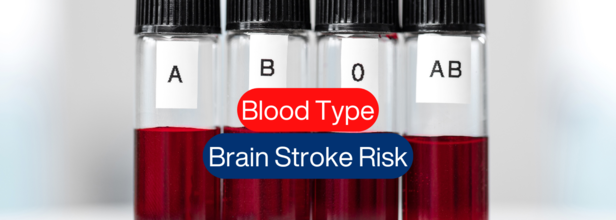- Health Conditions A-Z
- Health & Wellness
- Nutrition
- Fitness
- Health News
- Ayurveda
- Videos
- Medicine A-Z
- Parenting
Are You At Risk For Early Stroke? Your Blood Type Could Hold The Answer

Are You At Risk For Early Stroke? Your Blood Type Could Hold The Answer
The blood group you belong to is more than just a marker to match your donation; it may have something telling you about your probability of acquiring certain diseases. A new study published in the Journal of Neurology notes that it can be made an assumption from your blood group by which you are most likely to have an early-onset ischemic stroke at the age under 60.
Although the factors like genetics, age, and lifestyle are the factors that best contribute to the risk of a stroke, this new research has really shed new light on how blood group can be considered as playing a pivotal role than ever thought.
How Your Blood Type links to Stroke Risk?
A study suggests that an independent relationship exists between blood type A and an elevated risk for an early-onset ischemic stroke. Ischemic strokes are the presence of a blood clot in one artery, which causes blockage of blood flow to the brain, and about 90% of all stroke cases. The CDC suggests that in the United States, someone has a stroke every 40 seconds while one person dies from a stroke every 3.5 minutes.
This new research, hence, opens the possibilities that an earlier incidence of ischemic stroke in youth could be attributed to blood type A.
But it's worth remembering that blood type is just one of hundreds of risk factors, according to co-author Braxton Mitchell, PhD, MPH, a genetic epidemiologist at the University of Maryland School of Medicine. "In the grand scheme of things, it's a much smaller risk factor than others," he said. Other genetic, environmental, and lifestyle factors still determine stroke risk.
Blood Type A: Strong Link to Early-Onset Stroke
Study authors conducted a genome-wide association analysis, recruiting nearly 17,000 patients with stroke aged 18 to 59 years from 48 studies and more than 599,000 controls who never had a stroke history. The analysis was aimed at exploring genetic variants throughout the human genome in greater detail.
The ABO blood group possessed genetic differences, and the blood type A was the strongest risk factor for a stroke that occurred early in life. The possibility of having an early onset ischemic stroke was 18% higher among people with blood type A compared to the rest of the blood groups. Such a high risk could be associated with a higher susceptibility to blood coagulation, which is one of the most common causes of ischemic strokes.
Blood Type O: Lower Stroke Risk
On the other hand, individuals with type O blood have a 12% reduced risk of an early-onset stroke compared to other blood types. This is in-line with earlier research that has found people with type O blood are more likely to be at low risk for blood clotting inside their arteries, which could be the reason why their overall risk of having a stroke decreased.
Blood Type B and AB: Mixed Bag
Another blood group-the research looked at blood group B-for which a weak association is found with the onset of early and late stroke. However, the authors indicate that when sex and other risk factors are adjusted, no association between blood group B and increased stroke risk exists. In persons with blood group AB, there is no significant association discovered for having an elevated stroke risk.
Other Risk Factors
While this study points to the effect of blood type, it is important to understand that blood type alone is not a strong predictor of stroke risk. Many other factors are comprised in this, including lifestyle, and most importantly, underlying health conditions. Age is one critical factor. According to the CDC, your risk for stroke doubles with each decade after age 55.
While strokes are more likely to affect people who are 65 years of age and older, one in seven strokes strikes people aged 15 to 49.
Thirdly, gender another factor that has been related to increased risks of stroke conditions. The female population is more prone to stroke compared to the male population and tends to have a worse outcome in terms of disability and death due to stroke.
It was recently indicated in the 2022 study that young women aged between 35-45 years had a 44% increased risk of ischemic stroke as compared to men aged between 35-45 years. Perhaps pregnancy or the use of birth control could be some of the factors behind the usual increased risk in women.
Ways You Can Manage Stroke Risk
While the study does show a genetic element linked to blood type and stroke, other controllable factors are more important risks for stroke. Here are some steps you can take to reduce your total risk:
1. Control Blood Pressure: High blood pressure forms one of the most dominant risks for strokes. Control through regular monitoring, medication if required, and lifestyle modifications can prove to reduce this significantly.
2. Maintain a Healthy Weight: Being overweight increases the risk of stroke. Anyone can benefit from staying at a healthy weight and living a healthy lifestyle. A balanced diet and regular exercise can help you achieve and maintain a healthy weight and thus minimize your risk for stroke.
3. Reduce Alcohol Intake and Quit Smoking: Too much alcohol drinking and smoking are also significant risk factors for stroke. Cutting down on alcohol consumption and quitting smoking would be two very important lifestyle changes for anyone interested in being healthy.
4. Stay Physically Fit: Exercise is known to keep the heart healthy, reduce blood pressure, and promote a healthy weight all of which contribute to a decrease chance for stroke.
5. Monitor Your Cholesterol: It's a fact that high cholesterol builds up plaques in arteries, thereby increasing the chances of stroke occurrence. Fruits, vegetables, whole grains, and lean proteins are part of a heart-healthy diet that helps keep cholesterol at bay.
This research thus brings forward a new and enlightened perspective of the correlation between blood type and stroke risk, especially in younger ages. Although type A blood might have a propensity for developing early ischemic stroke, it is worth noting that this is just one of many factors responsible for developing a stroke.
Focusing on controllable lifestyle factors such as remaining within a healthy weight range, staying active, and managing blood pressure will help significantly reduce the chances of having a stroke regardless of the blood type.
Delhi Sees Some Relief From Toxic Air; GRAP IV Removed, 'Will Bring Down Pollution In 5 Years,' Says Nitin Gadkari

Credits: iStock
Delhi finds itself in a little relief as the AQI of the city has dropped to 221 as per the CAQM. GRAP IV restrictions have also been lifted, however, pollution and smog continues to take over the city. The Meteorological Department has issued a yellow alert for the next few days, which could affect road and air traffic.
While GRAP IV is now removed, measures under GRAP I, II, and III will continue. As per the IMD forecast, this is what could happen for the next 5 days in Delhi
- December 26: Dense fog will prevail in the morning. Visibility is likely to be low.
- December 27: Yellow alert, dense fog in the morning and afternoon.
- December 28: Yellow alert, moderate to dense fog expected in the early morning.
- December 29-30: Fog will reduce slightly, but moderate haze will prevail in the morning.
Union Transport Minister On Delhi's Pollution
Nitin Gadkari, Union Minister of Road Transport and Highways also highlighted the alarming conditions of Delhi's smog and pollution. He said, "I stay for hardly two days in Delhi, and get an infection," as he spoke on how pollution impacts one's health conditions. However, he did speak on the severity of pollution and highlighted how the transport sector could play a huge role to bring relief to Delhi.
He highlighted that fuel combustion and transport emission leads to most of Delhi pollution.
In an interview with the news agency ANI, the minister also said that his ministry and Central Government are working on several projects and initiatives that will free Delhi from air pollution in the next five years.
Gadkari stated that the Ministry of Road Transport and Highways is undertaking projects worth Rs 1 lakh crore in Delhi to ease traffic congestion. He stated that all these efforts will not only help free Delhi of air pollution but also reduce the country's imports, increase job opportunities, and help farmers.
Electric Buses, Cars, and Scooters
The minister highlighted that 40% of the air pollution in the National Capital region is due to the burning of fossil fuels. In this regard, the government introduced electric buses in the city and enabled automakers to introduce electric cars and two-wheelers in the country.
He further stated that alternate fuel vehicles, such as those that run on CNG, LPG, and flex fuels (E20), are also being introduced and that all these efforts combined will reduce the city's pollution levels.
CNG And Bitumin From Rice Straw
Gadkari pointed out that nearly 200 lakh tonnes of rice straw or parali is burnt in Haryana and Punjab, a major cause of air pollution in the Delhi-NCR region. In this regard, the government is setting up 400 plants to convert the rice straw into CNG. At the moment, 60 plants are operational.
The minister also discussed a new project in Panipat in which rice straw is being used to create 1 lakh litres of Ethanol, 1.5 tonnes of bitumen, and 78,000 tonnes of jet fuel.
Essential Tests Every Woman Should Go Through Before 2025 Ends

Credits: iStock
As the year draws to a close and 2026 approaches, most women find themselves juggling work deadlines, family responsibilities, and festive plans. In the middle of it all, personal health often slips to the bottom of the list. But doctors say this is exactly the time to pause and take stock of your body, especially your reproductive and hormonal health.
“Annual gynecological screening is one of the simplest ways to prevent silent illnesses, detect early changes, and understand your reproductive health better,” says Dr Tanveer Aujla, Consultant Obstetrician and Gynecologist at Motherhood Hospitals, Noida. Many common conditions show little to no symptoms in the early stages, making routine testing crucial.
Why yearly gynecological check-ups matter
Women often ignore subtle signs like fatigue, irregular periods, unexplained weight changes, or mood swings, assuming they are part of a busy lifestyle. According to Dr Aujla, this delay can be risky. “Conditions like cervical abnormalities, breast lumps, thyroid disorders, vitamin deficiencies, or hormonal imbalance often develop quietly and show symptoms only later,” she explains. A yearly check-up helps catch problems early and allows women to plan their health with confidence, especially if pregnancy is on the horizon.
Pap smear and HPV testing for cervical health
One of the most important screenings is the Pap smear combined with HPV testing. The Pap test looks for abnormal cells on the cervix, while the HPV test detects high-risk viruses responsible for most cervical cancers. “Together, they form a powerful screening tool,” Dr Aujla says. Women between 25 and 65 years should undergo this test every three to five years, or as advised by their doctor.
Breast screening for early detection
Breast health should never be overlooked. Dr Aujla advises yearly mammograms for women above 40, along with clinical breast examinations or ultrasound scans when needed. “These screenings help identify lumps, cysts, or early tissue changes,” she notes. She also stresses the importance of monthly self-examination to check for lumps, pain, or changes like inverted nipples.
Thyroid testing for unexplained symptoms
Thyroid disorders are extremely common in women and often remain undiagnosed. “A simple TSH, T3, and T4 test can explain symptoms like fatigue, mood swings, irregular periods, weight changes, or fertility issues,” says Dr Aujla. Early diagnosis can significantly improve quality of life and prevent long-term complications.
Fertility markers and preconception screening
Tests like AMH offer insight into ovarian reserve and help women plan their reproductive timelines. Dr Aujla points out that this is especially important for women with PCOS, irregular cycles, or delayed family planning. Preconception screening, which includes anemia levels, vitamin D, rubella immunity, blood sugar, and hormonal panels, ensures the body is prepared for a safe pregnancy.
Other essential health screenings
Women over 30 or those with a sedentary lifestyle should also get diabetes and cholesterol tests. Bone health panels checking calcium and vitamin D help prevent future osteoporosis. STI screening is equally important, as infections like chlamydia or gonorrhea can silently damage reproductive health if left untreated.
“Whether you are planning pregnancy or simply want to stay healthy, these tests offer clarity, confidence, and peace of mind,” Dr Aujla concludes. Taking time for these screenings before the year ends is a small step that can protect your health for years to come.
Is Santa Claus Bad for Your Health? Here’s Why a Doctor Is Raising Concerns Ahead of Christmas

Credits: iStock
Santa Claus is bad for your health! This is a statement by Dr Nathan Grills, a Public Health Fellow in the Department of Epidemiology and Preventative Medicine, Monash University, Australia. Why is he saying this right ahead of Christmas?
Writing for an article in the British Medical Journal's Christmas issue (BMJ), he says, "Santa only needs to affect health by 0.1% to damage million of lives". He says it would be better if his popularity was rather used to promote healthy living.
Why Is Santa Claus Unhealthy?
Santa Claus's portrayal is where the concerns lie. This was not the first time someone has talked about. In fact, The Conversation in December 2024, talked about this exactly. If you look at Santa, he stands anywhere between 5'6" to 6'6" and weighs between 80Kgs to 136Kgs. He also carries a lot of weight around his belly, which, some may say, keeps him insulated as he sleighs through the snowy lands, but is sure overweight and obese. These portrayal promotes an unhealthy living.
Dr Grils also writes that Santa should rather share Rudolf's snack of carrots and celery sticks than brandy and mince pies, and swap his reindeer for a bike or a walk.
After reviewing existing literature and online sources to understand Santa Claus’s possible impact on public health, the analysis found no peer-reviewed studies directly addressing the issue. What did stand out, however, was the exceptionally high level of awareness of Santa among children. In fact, surveys of American schoolchildren showed that Santa Claus was recognized more widely than almost any other fictional character, second only to Ronald McDonald.
The doctor says that Santa is also used for selling products, which are mostly harmful, and this happens on global scale, which means, people get inspired. "Santa sells, and sometimes he sells harmful products. Like Coca-Cola, Santa has become a major export item to the developing world."
While Santa has been banned from smoking, but his images of enjoying a pipe or cigar are easily found on Christmas cards. The depiction of Santa does form a public perception, argues the doctor.
Dr Grill also notes that Santa may be promoting potential drink-driving, especially when someone follows the tradition to leave him a brandy to wish him well on his travels, while he has billion houses to visit.
Can Santa Spread Diseases?

Dr Grill says that he can spread diseases. If Santa sneezes or coughs around 10 times a day, all the children who sit on his lap may also end up catching the flu along with their Christmas presents.

However, it is important to note that these are views expressed by the doctor and no actual studies have been conducted on the same, Though Dr Grill does indicate for more research before calling for authorities to regulate Santa's activities. For now, Dr Grill proposes a new image for Santa, a healthier one. A slim Santa on a treadmill.
© 2024 Bennett, Coleman & Company Limited

